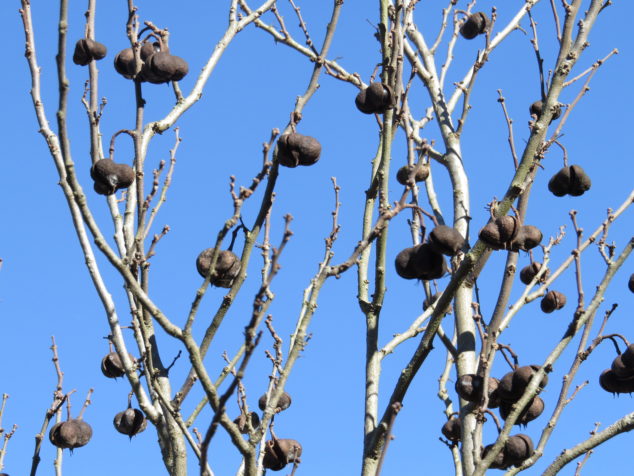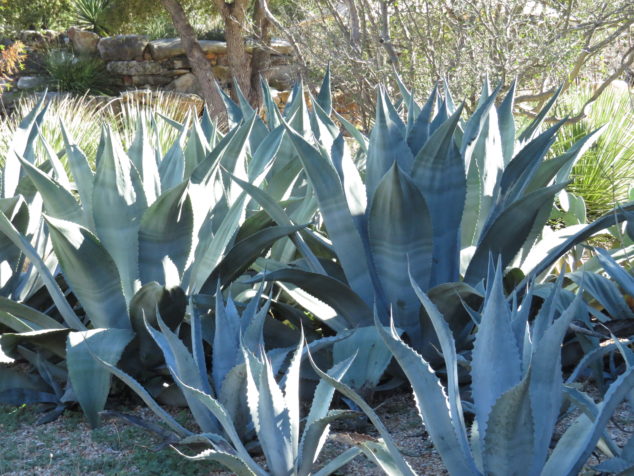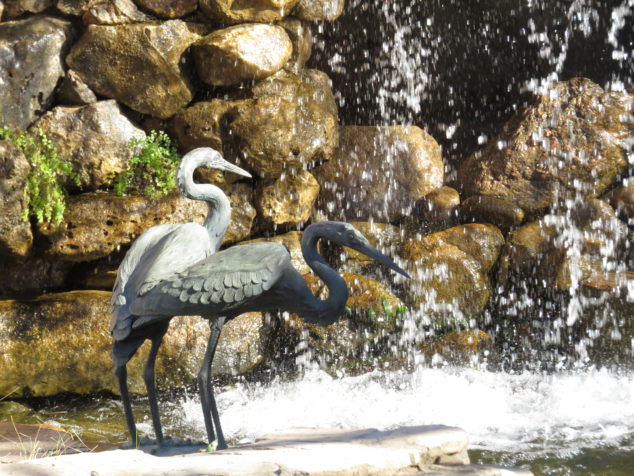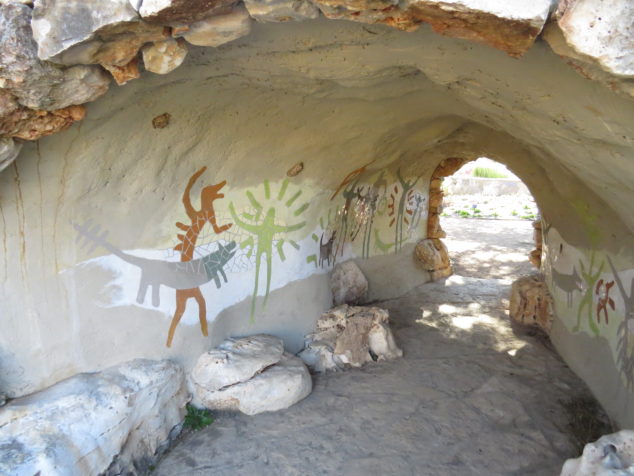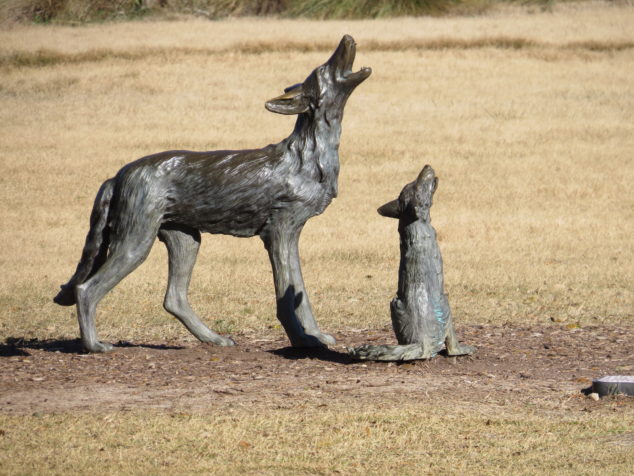My special cause, the one that alerts my interest and quickens the pace of my life, is to preserve the wildflowers and native plants that define the regions of our land—to encourage and promote their use in appropriate areas, and thus help pass on to generations in waiting the quiet joys and satisfactions I have known since my childhood. –Lady Bird Johnson
Lady Bird Johnson, wife of our 36th President Lyndon B. Johnson, along with actress Helen Hayes founded the National Wildflower Research Center in 1982 on 60 acres of land in East Austin, Texas. It moved to its present location in southwest Austin in 1995 and now includes 284 acres of native trees and plants, Texas architecture, a family garden dedicated to nature play for children, and thousands of species of insects, butterflies, birds, and mammals. It also has numerous art installations like this rock and glass sculpture glowing in the sunlight in front of luminous grasses.
The Wildflower Center has a rain collection system that is capable of storing 68,500 gallons of water! Rock pillars have an aqueduct on top to bring rainwater to the round cistern at the entrance.
We climbed the Observation Tower, a brown sandstone landmark that offers spectacular views from the top, a seating area midway up with green roof, and is itself a 5,000-gallon rainwater cistern.
The Woodland Garden—and many other areas of the Center—was lined with luminaries for their winter light festival.
As we followed the stream, Emily noticed a snake slithering alongside of us. He crossed the stream to the other side, and then I noticed the name of the tree he crawled under: Eve’s Necklace, a small tree with compound leaves, clusters of pink pea-like flowers, and fruits of a slender string of shiny, black beads that contain the seeds.
The environment is where we all meet; where we all have a mutual interest; it is the one thing all of us share. It is not only a mirror of ourselves, but a focusing lens on what we can become. –Lady Bird Johnson
We marveled at all the structures and fences that were made from cedar posts and poles and at the trees and plants that were so unfamiliar to us. We came across some Texas versions of familiar species—Bushy Bluestem and Mexican Buckeye.
As we entered the Woodland Trail, we heard chimes long before we saw where the sound was coming from. It was a windy day, so the music in the woods was loud and boisterous! Three or four trees along the trail had the large wind chimes dangling from their bare branches.
Sculptures of woodland creatures lined the trail, almost as surprising as if we had met a live one.
My heart found its home long ago in the beauty, mystery, order and disorder of the flowering earth. –Lady Bird Johnson
Lady Bird Johnson grew up in East Texas but was captivated by the fields of Bluebonnets she saw when she flew to Austin in 1930—and by the tall Texan named Lyndon Johnson. Seedling Bluebonnets grew all along the trail—what a spectacular sight they must be in the spring!
Prickly Pear cactus is everywhere in and around Austin—the wild, spiny kind with bulbous red fruits and the spineless, landscape varieties.
Hello, Armadillo! (Would love to see one ‘in person.’)
I loved the Century Plants!
Dinosaur Creek flowed from a waterfall and pond to these tributaries.
Children are likely to live up to what you believe of them. –Lady Bird Johnson
The children’s nature play area was fun and adventurous—we didn’t see many children since it was a school day, so we explored by our adult selves.
I first heard the word stumpery just this year when we watched a British garden show—apparently they are popular and originated in England. This stumpery at the Wildflower Center is for children to climb on.
A line of Arizona Cypress trees were covered with colorful Christmas balls with a tree skirt of yuccas.
A rendezvous-like fort area was missing just one thing—the kids!
Beautification is far more than a matter of cosmetics. For me, it describes the whole effort to bring the natural world and the man-made world into harmony; to bring order, usefulness — delight — to our whole environment, and that of course only begins with trees and flowers and landscaping. –Lady Bird Johnson
This beautiful little tree is called Huisache or Sweet Acacia. It’s often multi-stemmed, has feather-like leaves, fragrant bright orange flowers in spherical clusters, and small, brown seedpods. They categorize it as semi-evergreen, which is new to me. It was strange to come to Austin in December and see some of the trees still holding on to their green leaves while others had dropped their leaves.
Two seasonally festive trees and shrubs with red berries dotted the landscape of the gardens—one, the Possumhaw tree and the other, Yaupon, shown below. Both are types of holly. The Yaupon shrub is evergreen, and the leaves were used by Native Americans as a drink in purging rituals, thus its name Ilex vomitoria. It is now known that the tea made from the leaves does not cause vomiting. Good thing! I have some in my cupboard! It is the only native North American plant that contains caffeine, and it is rich in polyphenols just like tea and coffee.
For the bounty of nature is also one of the deep needs of man. –Lady Bird Johnson
Long before Instagram there was a shy, young Texas girl who became a powerful influencer. Her dream and intention of conservation and beautification took her from Karnack, Texas, to Austin, to the White House, and back to Austin. She was the major influence for the 1965 Highway Beautification Act and many other environmental bills during her husband’s administration. She joined the President’s War on Poverty by founding Head Start with Sargent Shriver. She was the business owner of an Austin broadcasting company. She was a major influencer in the development of the Town Lake Trail in Austin, and urged The Nature Conservancy to buy Enchanted Rock so it would be preserved for all to see. She dreamed of a research center for conservation, native plants, and wildflowers and made it happen! The environment—the land, the people we surround ourselves with, the things we say and do—is where we all meet and greatly influences who and what we become. As Lady Bird said of children, so it is with all people—we are likely to live up (or down) to what is believed of us by leaders, influencers, authorities, and loved ones. Lady Bird Johnson’s website says of her: She was bold. She was compassionate. She was visionary. She was an adventurer. She was generous. She believed in the power of healthy landscapes to transform lives. #BELIKELADYBIRD











